Wishing Trees
In the Lake District of northwestern England, a river called the Aira Beck drops 72’ in a dramatic waterfall known as the Aira Force (pictured below). It’s one of the most famous spots in the District, providing inspiration for many artists and poets, including William Wordsworth. Near the cascade is a special tree where visitors have hammered coins into a fallen trunk. Not just a few coins – many thousands of them, so many the trunk seems to be coated in metal pieces.


It’s one of dozens of “coin trees” in Scotland, Ireland, England, and Wales. Most of them are near a water source.
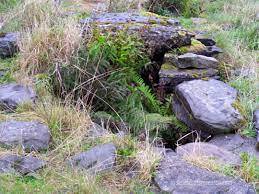
In 1877, Queen Victoria made a note in her journal about pounding a coin into a wishing tree on Isle Maree in Scotland. That tree, and others near it, are now covered with hammered-in coins. They’re near the healing well of Saint Maelrubha (pictured), where offerings were often made, including sacrificing bulls, right up to the 18th century. Recent research has shown human presence at the site may be over 10,000 years old.
What’s their purpose?

When asked why they pound coins into a wishing tree, people usually say it’s an offering, a payment in return for a favor, like a votive candle in church. In one sense, it’s like the coins people throw into a fountain. But in another way, it’s a communal act rather than an individual one. It’s the creation or reinforcement of a very important place, one coin at a time. There are other trees near waterfalls or springs, but each wishing tree has become, by its long history, the best place in the area to hammer in an offering.
And it has a ritual quality. Each coin is placed in a row with others, hammered in the same way, often with the hammer stone left at the site. Each piece adds to the power of the place and increases the appeal to those passing by.
Folklore and Fairies
One theory is that the practice of driving in metal bits began with an old hawthorn tree in Scotland known as the “Kissing Tree.” Local belief was if a young man could drive a nail into the tree with one hit, he could demand a kiss from his sweetheart since he was clearly a good choice as a suitor.
The coin tree near Ardmaddy House in Argyll, Scotland, is also a hawthorn, a species long associated with magic. Tradition says any wish you make on it will be granted.
Older explanations are more protective: the offerings were designed to appease the aos si, the fairies, who could easily cause mischief or disaster, particularly with farm animals.
Clootie Trees



In a study of holy wells in Ireland, Clare Monardo found that almost every town has one, though many are not labeled as such for visitors. She found them to be an amalgam of Pre-Christian and Christian practices, often decorated with offerings ranging from crosses, rosaries, religious statues, prayer cards, flowers, and photos, to strips of fabric, known as clooties, tied to a nearby tree. According to tradition of the area, the person making the wish ties a ribbon or strip of cloth to the tree after dipping it in the holy well, hoping to transfer their troubles to the tree and well.
In some places, both clooties and coins decorate the special tree.
Other versions
As the point of contact between heaven and earth, trees have always been impressive to people. The tree by a special body of water even more so. In these photos, you can see trees from many areas festooned with spiritual and commercial tokens, amplifying their impact on the viewer and therefore their power.
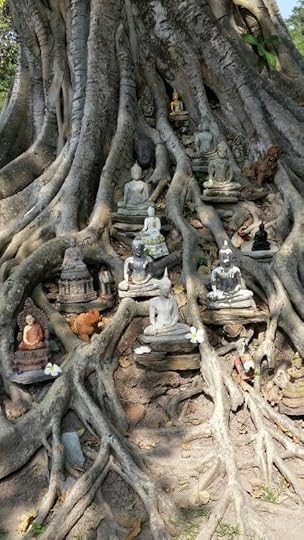

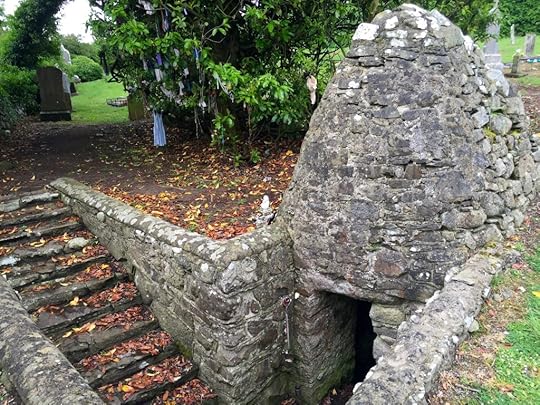
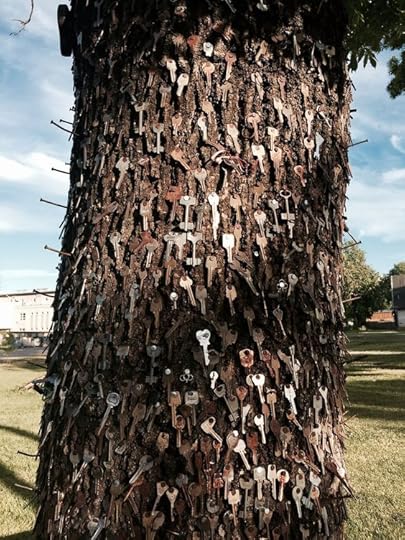


Photos include a spirit tree with statues of Buddha, a well with photos and memorabilia, a mysterious tree full of keys, a clootie tree by one of the many Saint Brigid’s wells, a Siberian shaman with prayer cloths, and a New Year’s Day wishing tree in Hong Kong.

In an interesting example of current events recycling the ancient past, a local businessman in Naples, Italy, donated several Christmas trees to the Galleria Umberto, to be used as “wishing trees.” People could write their wishes on slips of paper and attach them to the tree, in much the same way as people have, for centuries, left messages with statues of saints. The idea proved to be very popular, even after one of the trees was stolen by some local teenagers and had to be replaced. The papers included wishes like “Please make my mother well again,” “Please bring peace to the warring lands,” Please make this year better than last year,” and so on. One asked for a better season for the local football (soccer) club.
There are many modern versions, but none seem to have the spiritual presence and power of the ancient sites, because the spirit (tree spirit, water spirit, goddess, god, saint) has been removed. There’s no powerful entity acknowledged as the one meant to answer the request. Perhaps for those pinning their wishes on the trees, it’s enough to add them to the communal wishing area. Or maybe communal energy itself is the goal. Or, once decorated with these wishes, the tree itself becomes something more powerful than it used to be.

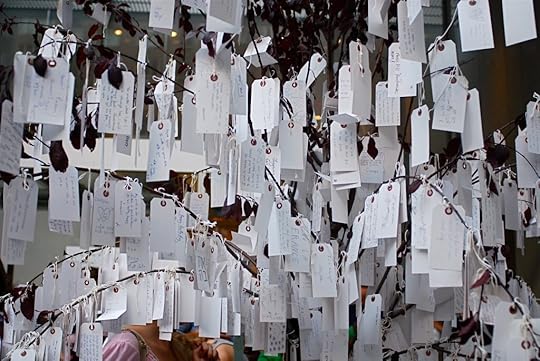
That seems to be the case in Yoko Ono’s work, Wish Tree, which was installed in the Sculpture Garden of the Museum of Modern Art in New York City. Another version, Wish Tree for Washington D. C. was installed earlier. Both feature messages written by visitors from all over the world.
Are they the same messages people thousands of years ago might have left at a powerful spirit tree next to a spring? Maybe not. But then again, maybe they’re not that far removed.
Sources and interesting reading:
“Aira Force,” Wikipedia, https://en.wikipedia.org/wiki/Aira_Force
“Clootie well,” Wikipedia, https://en.wikipedia.org/wiki/Clootie_well
Mathews, Jeff, “The Wishing Tree,” Naples: Life, Death & Miracles blog, www.naplesldm.com/wish.php#/
Meier, Allison, “Wishing Trees: Where Money Grows in the Branches” Atlas Obscura, 30 July 2014, https://www.atlasobscura.com/areticles/wishing-trees/ A great source for photos of coin trees.
“St. Maelrubha’s Well, Isle of Skye, Scots Roots blog, 15 May 2015, https://scotsroots.wordpress.com/2015/05/15/st-maelrubhas-well-isle-of-skye/
“Wish tree,” Wikipedia, https://en.wikipedia.org/wiki/Wish_tree
All photos were taken from these sources.
 newest »
newest »
 nice
nice



